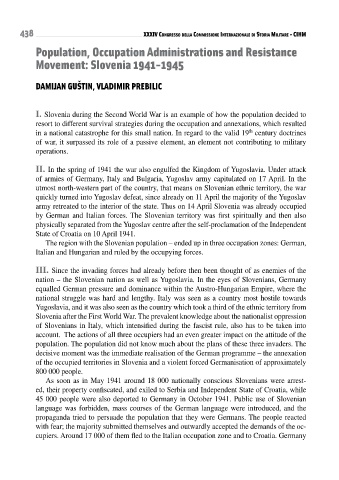Page 438 - Conflitti Militari e Popolazioni Civili - Tomo I
P. 438
438 XXXIV Congresso della CommIssIone InternazIonale dI storIa mIlItare • CIHm
Population, Occupation Administrations and Resistance
Movement: Slovenia 1941-1945
DAMIJAN GušTIN, VLADIMIR PREBILIC ̌
i. Slovenia during the Second World War is an example of how the population decided to
resort to different survival strategies during the occupation and annexations, which resulted
th
in a national catastrophe for this small nation. In regard to the valid 19 century doctrines
of war, it surpassed its role of a passive element, an element not contributing to military
operations.
ii. In the spring of 1941 the war also engulfed the Kingdom of Yugoslavia. Under attack
of armies of Germany, Italy and Bulgaria, Yugoslav army capitulated on 17 April. In the
utmost north-western part of the country, that means on Slovenian ethnic territory, the war
quickly turned into Yugoslav defeat, since already on 11 April the majority of the Yugoslav
army retreated to the interior of the state. Thus on 14 April Slovenia was already occupied
by German and Italian forces. The Slovenian territory was first spiritually and then also
physically separated from the Yugoslav centre after the self-proclamation of the Independent
State of Croatia on 10 April 1941.
The region with the Slovenian population – ended up in three occupation zones: German,
Italian and Hungarian and ruled by the occupying forces.
iii. Since the invading forces had already before then been thought of as enemies of the
nation – the Slovenian nation as well as Yugoslavia. In the eyes of Slovenians, Germany
equalled German pressure and dominance within the Austro-Hungarian Empire, where the
national struggle was hard and lengthy. Italy was seen as a country most hostile towards
Yugoslavia, and it was also seen as the country which took a third of the ethnic territory from
Slovenia after the First World War. The prevalent knowledge about the nationalist oppression
of Slovenians in Italy, which intensified during the fascist rule, also has to be taken into
account. The actions of all three occupiers had an even greater impact on the attitude of the
population. The population did not know much about the plans of these three invaders. The
decisive moment was the immediate realisation of the German programme – the annexation
of the occupied territories in Slovenia and a violent forced Germanisation of approximately
800 000 people.
As soon as in May 1941 around 18 000 nationally conscious Slovenians were arrest-
ed, their property confiscated, and exiled to Serbia and Independent State of Croatia, while
45 000 people were also deported to Germany in October 1941. Public use of Slovenian
language was forbidden, mass courses of the German language were introduced, and the
propaganda tried to persuade the population that they were Germans. The people reacted
with fear; the majority submitted themselves and outwardly accepted the demands of the oc-
cupiers. Around 17 000 of them fled to the Italian occupation zone and to Croatia. Germany

